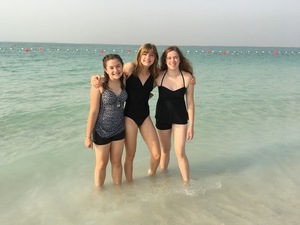Period 1: 1491-1607
Beschreibung

|
Erstellt von Jamila Mastny
vor etwa 6 Jahre
|
|
Zusammenfassung der Ressource
Seite 1
The American Yawp: Ch 2: Colliding Cultures
I. Introduction Columbian exchange transformed both sides of the Atlantic: new food introduced- population boom in europe entire civilizations killed- due to new diseases Spain gained wealth from riches gained from Aztecs/Incans Portugal,France,Netherlands,England race to new world to match spanish gains: Native people welcomes newcomers and trade helped establish new settlements along coast By the end of 1th century, Spain loses rival status Age of colonization and collision of cultures begins
II. Spanish America spain extended its reach to the Americas expeditions began bringing Europeans to USA to establish religiou/economic dominance: *Juan Ponce de Leon (1513) arrived FL, found Natives who were dieing, but no wealth (1st 1/2 of 16th c.) spanish fought w/ Florida Natives and Europeans (17th c.) Spains reach in America was roughly 1,000 sq miles (1630s) mission reach extended to Apalachee tribes territory- agriculture centered indian tribe Santa Fe(1610)- Euro. 1st permanent settlement in SW did not populate fast due to distance from Mexico City.... so Spain never achieved dominate presence in area, (1680) only about 3000 colonists to call N Mexico home- people traded w/ Puebloan people missions became driving force for colonization in N America
III. Spain’s Rivals Emerge While Spain explored new world, Europeans began competition, England/France began reigious and political conflict, millions died but as violence deminished in europe, eigious and political conflict continued in the new world The French early french explorers sought NW Passage- waterway through N America to Asia French settlements develpoed w/ the help of trading- french placed higher value on cooperation w/ Indians Jesuit missionarieshad different strategies than spanish missionaries, often fur trders marriedindian women Huron peopleclose relationship w/ French, some converted, these relationships had high cost w/ disease, etc. still french on the "middle ground" great lakes area- adopted some indian customs while indians engaged in some european laws The Dutch Netherland, achieved considerable colonial success dutch had better freedom rights than other euro. contries, so eligious freedom seekers went to the Netherlands although they offered lberties, offered little democracy, slavery was essential to dutch capitalist triumphs *Henry Hudson found hudson river and clamined modern-day NY also dutch established carribean colonies and trade attacks dutch adopted *Hugo Grotius (philospher) ideas of peaceful land distribution w/ Indians dutch sought to profit, not conquer: developed trading networks, settlements, and large plantations (which helped deterorate native relationships) Labor shortages were met w/ slaves beginning in 1626 The Portuguese Portuguese had been ahead of Columbus, but the wealth coming from spain, made the rivalry between the two contries the worst it had ever been this rivalry started a crisis for the catholic world, causing the pope to dividethe new world w/ the Treaty of Tordesillas (1494) w/ license to conquer both spain and portugal were told to treat natives with respect and convert them
IV. English Colonization
V. Jamestown
VI. New England
VII. Conclusion
Seite 2
Native American Civilisations
Native American Civilisations (pre-Columbus): The original discovery of North America at least 10,000 years before Columbus was born (estimated: 40,000 yrs ago) native people settled in N America the native peoples came across land bridge- Bering Strait thru AK down to all of the Americas Evolved into 100s of tribes with distinct languages and cultures 20 language families w 400+ languages Population estimates from 50-100 million people Cultures of Central and S America People mainly in 3 highly developed civilizations 300-800 AD Maya on Yucatan Peninsula decline- 8-9th-century unknown reason Mayan cities were abandoned specialties- build remarkable cities agriculture- swampy lowlands, built raised platforms, surrounded by canals where they grew crops in forest, used slash/burn technique to create flat surface to plant crops built raised earth platforms, surrounded by canals, on which they could grow crops, dug canals through fields to irrigate crops Same time as Aztecs- Inca, Peru, huge empire in S America Aztecs-decline- Spanish conquistador Hernan Cortez specialties- powerful empire, dominating central Mexico agriculture- used Chinampas, artificial islands to farm crops Incas All highly organized societies, much trade, accurate scientific calendars, crops for stable food supply Maize- Aztec & Maya, Potatoes- Inca
Seite 3
Europe Moves Toward Exploration
vfvfv
Seite 4
European Exploration
Seite 5
Columbian Exchange
The Columbian exchange, also known as the Columbian interchange: was the widespread transfer of plants, animals, culture, human populations, technology, and ideas between the Americas, West Africa, and the Old World in the 15th and 16th centuries, related to European colonization and trade following Christopher Columbus's 1492 voyage. invasive species, including communicable diseases, were a byproduct of the Exchange. changes in agriculture significantly altered and changed global populations. most significant immediate impact of the Columbian exchange was the cultural exchanges and the transfer of people between continents. Transfer of plants, animals, diseases, and people across Atlantic Native mortality rate >90%, millions died, including entire tribal communities Effects: Americas- Europeans- Africans-
Seite 6
European Settlements
Seite 7
Native American/European Relations
Seite 8
Period 1 Review
Key Concepts: as natives migrated W over time they developed distinct and complex societies by adapting/transforming their environment European/Native A/African contacts resulted in Columbian Exchange... ... which caused a change in social, cultural, and political exchanges globally and change in the way people lived their lives Key Points: U.S. today is a combination of people from around the world Columbus made a lasting impact on the Americas Columbian Exchange changed the way people lived/acted throughout the world Spanish/Portuguese formed colonies w help of enslaved Africans/Indians Natives resisted by maintaining the culture French/Dutch followed soon after and later English too
Möchten Sie kostenlos Ihre eigenen Notizen mit GoConqr erstellen? Mehr erfahren.
